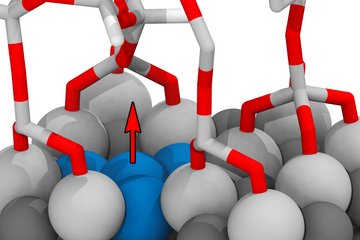All genres
81.
Talk
Interfaces engineering and nanoscale characterization of alternative buffer layers in chalcopyrite thin film solar cells. 2015 Spring Meeting - E-MRS, Lille, France (2015)
82.
Talk
Atom probe tomography study of internal interfaces in Cu2ZnSnSe4 thin-films. E-MRS Spring Meeting 2015, Lille, France (2015)
83.
Talk
Interfaces in Semiconductors: Application to photovoltaic materials. 61st American Vacuum Society International conference, Baltimore, MA, USA (2014)
84.
Talk
Atomic scale insights into Cu2ZnSnSe4 thin-film solar cells. Atom Probe Tomography & Microscopy 2014: APT & M 2014, Stuttgart, Germany (2014)
85.
Talk
Progress in interfaces characterization in solar cells using correlative techniques. Atom Probe Tomography & Microscopy 2014, Stuttgart, Germany (2014)
86.
Talk
On the Nano-scale Characterization of Thin-Film Solar Cells. Microscopy&Microanalysis 2014, Hartford, CT, USA (2014)
87.
Talk
Characterization of internal interfaces in Cu(In,Ga)Se2 thin-film solar cells using correlative microscopies. 40th PVSC IEEE 2014, Denver, CO, USA (2014)
88.
Talk
High temperature coevaporation of Cu2ZnSnSe4. E-MRS Spring Meeting 2014, Lille, France (2014)
89.
Talk
Atom Probe study of Cu2ZnSnSe4 thin-film solar cells prepared by co-evaporation and post-deposition annealing. E-MRS 2014, Lille, France (2014)
90.
Talk
On the nano-scale characterization of kesterite thin-films. Seminar „Neue Materialien - Halbleiter“ 2014, Otto-von-Guericke University, Magdeburg, Germany (2014)
91.
Talk
Grain boundary characterization in multicrystalline silicon using joint EBSD, EBIC, and atom probe tomography. 40th IEEE Photovoltaic Specialists Conference, Denver, CO, USA (2014)
92.
Talk
A correlative EBSD, EBIC and APT study of grain boundary segregation in multicrystalline silicon. Atom Probe Tomography & Microscopy 2014, Stuttgart, Germany (2014)
93.
Talk
Atomic scale insights into Cu2ZnSnSe4 thin-film solar cells by APT. 4th European KesteriteWorkshop 2013, Berlin, Germany (2013)
94.
Talk
Role of internal interfaces in solar cells. International Workshop on Interface-dominated Materials, Bochum, Germany (2013)
95.
Talk
Characterization of Cu2ZnSnSe4 thin-film solar cells. Euromat 2013, Sevilla, Spain (2013)
96.
Talk
Internal interfaces in Cu(In,Ga)Se₂ thin-film solar cells. 1st IDSC workshop, Düsseldorf, Germany (2013)
97.
Talk
Correlative EBSD-TEM-APT studies of GBs in Cu(In,Ga)Se₂ thin-films solar cells. Sfmu 2013, Nantes, France (2013)
98.
Talk
Atom Probe Tomography. 2013 MRS Spring Meeting & Exhibit, San Francisco, CA, USA (2013)
99.
Talk
Exploring the internal interfaces in Cu(In,Ga)Se2 thin-film solar cells at the atomic-scale. 2013 MRS Spring Meeting & Exhibit, San Francisco, CA, USA (2013)
100.
Talk
Atom Probe study of Cu2ZnSnSe4 thin-film solar cells prepared by coevaporation and post-deposition annealing. MRS Spring Meeting 2013, San Francisco, CA, USA (2013)











